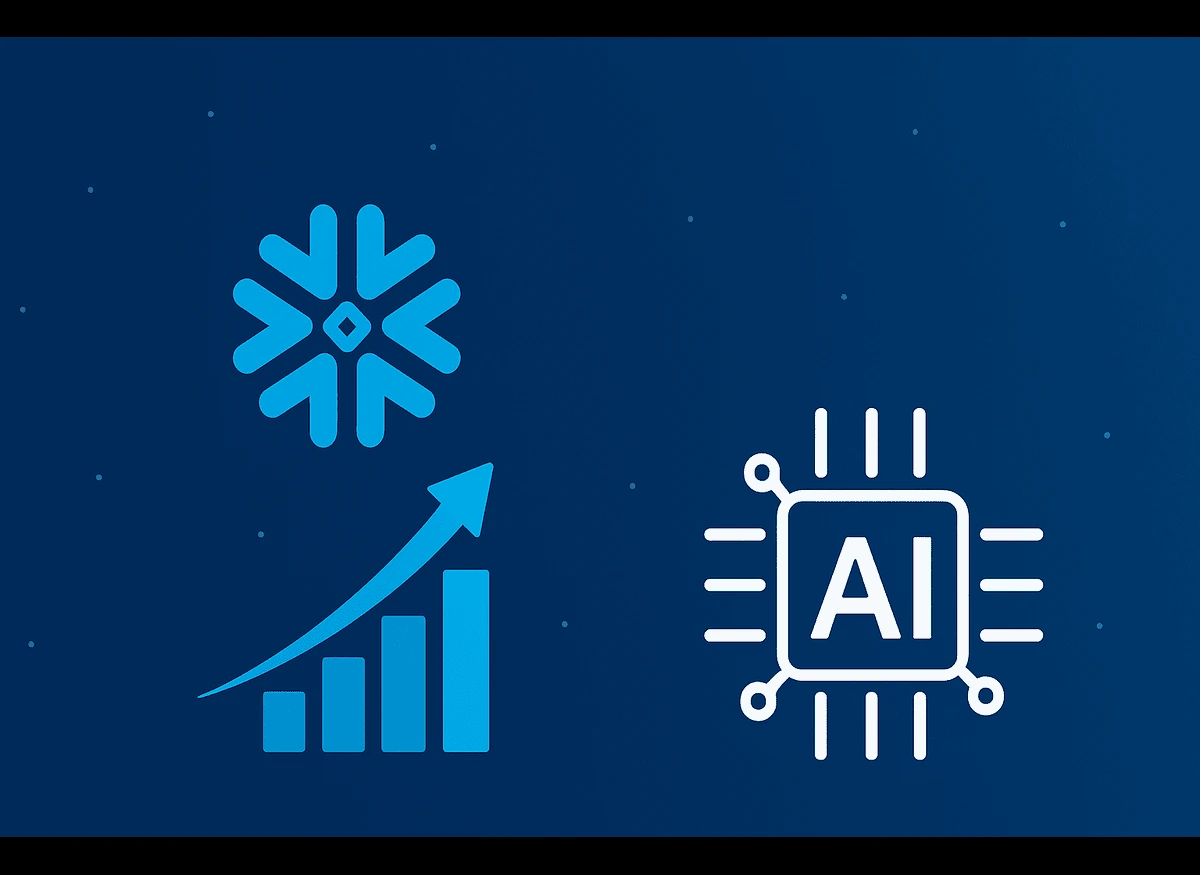
Snowflake’s $4.325B 2025 forecast signals AI-driven cloud growth. Azure, AWS, and GCP report strong revenue gains, with AI fueling a $723B market. Multi-cloud adoption, talent shortages, and partnerships shape 2025 trends. Strategic insights guide businesses and investors in the AI cloud era.
On May 22, 2025, Snowflake, a leading data analytics and cloud computing company, raised its fiscal 2026 product revenue forecast to $4.325 billion, surpassing analyst expectations of $4.21 billion. This 24% year-over-year (YoY) growth projection, coupled with a first-quarter fiscal 2026 product revenue of $996.8 million (up 26% YoY), highlights Snowflake’s strong momentum in AI-powered cloud services. Strategic partnerships with OpenAI and Anthropic have bolstered its Cortex AI platform, enab
ling enterprises to deploy advanced large language models (LLMs) for analytics, visualization, and automation. With a net revenue retention rate of 124% and 606 customers generating over $1 million in trailing 12-month revenue, Snowflake’s stock surged 6-11% in after-hours trading, reflecting investor confidence in its AI-driven strategy.
This announcement underscores a broader trend: the explosive growth of AI-powered cloud services. As enterprises increasingly adopt cloud-based AI solutions to drive innovation, providers like Snowflake, Microsoft Azure, Amazon Web Services (AWS), and Google Cloud Platform (GCP) are reporting significant revenue increases. This article explores Snowflake’s forecast within the competitive AI cloud landscape, and offers strategic insights into market trends and future projections.
The AI Push: Fueling Cloud Revenue Growth
The integration of artificial intelligence (AI) into cloud services has transformed the industry, driving unprecedented demand for scalable, high-performance infrastructure. According to Synergy Research Group’s 2025 Cloud Market Report published in 2025, global cloud infrastructure spending reached $91 billion in Q4 2024, with a projected 22% YoY growth in 2025, driven by AI workloads accounting for over 50% of market expansion since 2022.
The global cloud AI market, valued at $121.74 billion in 2025, is expected to grow at a compound annual growth rate (CAGR) of 39.7% to reach $647.61 billion by 2030, per Grand View Research’s 2025 AI Market Analysis (published March 2025). This growth is fueled by enterprise demand for generative AI, natural language processing (NLP), and automation across sectors like finance, healthcare, and retail.
Snowflake’s success reflects this trend. Its partnerships with OpenAI and Anthropic enable seamless LLM integration, allowing customers to build AI-driven applications without heavy infrastructure investments. Snowflake’s consumption-based model, combined with compatibility across AWS, Azure, and GCP, reduces vendor lock-in concerns and drives adoption. Its focus on Snowpark, Cortex, and Snowflake Intelligence positions it to capture adjacent markets, strengthening its role in the data cloud ecosystem.
Major Players: Azure, AWS, and GCP in the AI Cloud Race
Microsoft Azure: Enterprise Dominance with AI Integration
Microsoft Azure leads the AI-driven cloud market, leveraging its enterprise ecosystem and partnerships with AI leaders like OpenAI. In Q3 FY2025 (ended March 31, 2025), Microsoft’s Intelligent Cloud segment, including Azure, reported $26.8 billion in revenue, up 21% YoY, with Azure growing 33%, according to Microsoft’s Q3 FY2025 Earnings Report (April 2025). Azure’s AI business surpassed a $13 billion annual revenue run rate, up 175% YoY, driven by tools like Azure OpenAI and Microsoft 365 Copilot.
With 95% of Fortune 500 companies using Azure, Microsoft’s enterprise network is a key differentiator. The company reported over 60,000 AI customers in Q4 2024, a 60% YoY increase, per its 2025 AI Adoption Report (published in January 2025).
Azure’s strategic investments in data centers across Brazil, Italy, Mexico, and Sweden, combined with open-source AI models, attract enterprises seeking scalable solutions. However, Microsoft’s CFO Amy Hood noted challenges in scaling AI sales through channel partners, emphasizing the need to balance AI workload adoption with traditional cloud migrations, as highlighted in McKinsey’s 2025 AI Report .
Amazon Web Services: Market Leader with AI Innovation
AWS maintains its position as the cloud market leader, holding a 30% market share in Q4 2024 with $28.8 billion in revenue, up 19% YoY, per Amazon’s Q4 2024 Earnings Report (February 2025). AI-driven services, including Amazon Bedrock and Nova foundational models, have fueled growth, with AI-related revenue growing three times faster than its overall business. AWS’s introduction of models like Claude 3.5 Sonnet and Llama 3.2 via Bedrock and SageMaker has broadened its appeal. The company’s $75 billion capital expenditure in 2024, primarily for AI infrastructure, underscores its commitment to meeting GPU-based computing demand, as noted in BCG’s 2025 AI Impact Report (January 2025).
AWS’s mature ecosystem and extensive partner network provide a competitive edge, though it trails Azure in third-party model access. CEO Andy Jassy emphasized the role of custom Trainium 2 chips in addressing chip shortages, enhancing cost-efficiency for AI workloads.
Google Cloud Platform: Accelerating with AI Differentiation
Google Cloud Platform reported $12 billion in revenue in Q4 2024, up 30% YoY, with a $48 billion annual run rate, per Alphabet’s Q4 2024 Earnings Report (January 2025). Its growth is driven by AI capabilities, including Gemini 2.0 and Tensor Processing Units (TPUs), optimized for AI workloads. GCP’s revenue backlog grew to $93.2 billion, reflecting strong enterprise demand, as noted in Synergy Research Group’s 2025 Cloud Market Report. The Vertex AI platform, with a 14-fold increase in Gemini API usage in six months, has attracted clients like Bayer and Walmart. Google’s $7 billion investment in Q3 2024, including $6 billion for U.S. data centers, highlights its AI infrastructure focus.
GCP’s deep AI integration, with 36% of new case studies involving AI, positions it as a leader in generative AI innovation, per McKinsey’s 2025 AI Report. However, its 12% market share lags behind AWS and Azure, and capacity constraints remain a challenge. Alphabet’s CFO Anat Ashkenazi noted plans to increase 2025 capital expenditures to address this.
General Market Trends: AI as the New Growth Engine
The cloud computing market is undergoing a seismic shift, with AI as the primary catalyst. Key 2025 trends include:
AI-Driven Demand: Generative AI has driven over 50% of cloud market growth since 2022, per Synergy Research Group’s 2025 Cloud Market Report. New GPU-as-a-service offerings and infrastructure enhancements are accelerating adoption.
Hyperscaler Dominance: AWS, Azure, and GCP hold 64% of the market, growing 26% YoY in Q3 2024, with 2025 projections maintaining similar momentum, per Synergy Research Group.
Regional Growth: North America dominates with a 33.88% share of the cloud AI market, but Asia-Pacific is the fastest-growing region with a 25% CAGR, driven by investments in China, Japan, and India, per Fortune Business Insights’ 2025 AI Market Analysis (January 2025).
Hybrid and Multi-Cloud Adoption: 92% of companies will adopt multi-cloud strategies in 2025, per Nextwork’s 2025 Cloud Survey (February 2025), enhancing flexibility and reducing vendor lock-in.
Security and Skills Shortages: Cybersecurity remains critical, with 94% of businesses reporting improved security post-cloud migration. However, 60% face cloud talent shortages, driving demand for certifications, per BCG’s 2025 AI Impact Report.
Global cloud infrastructure spending is projected to reach $723 billion in 2025, with IaaS and PaaS segments growing 25% and 22%, respectively, per Synergy Research Group. The cloud AI market is expected to hit $121.74 billion in 2025, per Grand View Research’s 2025 AI Market Analysis.
Strategic Insights for Businesses and Investors
For businesses adopting AI-powered cloud services:
Leverage Partnerships: Snowflake’s partnerships with OpenAI and Anthropic highlight the value of integrating with leading AI providers. Businesses should prioritize platforms with robust ecosystems for cutting-edge model access.
Balance Cost and Scalability: Hyperscalers’ AI investments risk overcapacity, as noted by Canalys’ 2025 Cloud Outlook (March 2025). Companies must align AI adoption with clear ROI goals.
Invest in Talent: With 70% of IT professionals expected to hold cloud certifications by 2025, per BCG, training is critical to bridge skill gaps.
Embrace Multi-Cloud: Multi-cloud strategies, as seen with Snowflake’s cross-platform compatibility, mitigate vendor lock-in and enhance resilience.
For investors:
Snowflake’s Growth Potential: With a 24% revenue growth forecast and 124% net retention rate, Snowflake is a strong bet, with a $197.76 consensus price target (17.96% upside), per Yahoo Finance (May 2025).
Hyperscaler Stability: Microsoft’s enterprise dominance and Azure’s AI growth make it a safe investment. AWS’s scale and GCP’s AI innovation offer growth potential, though capacity constraints warrant caution.
Emerging Players: Oracle’s 45% cloud revenue growth in Q4 2024 and CoreWeave’s rise signal opportunities in niche AI infrastructure markets, per Synergy Research Group.
The Future of AI-Powered Cloud Services
By 2030, cloud computing sales could reach $2 trillion, with generative AI contributing 10-15% of spending, per Goldman Sachs’ 2025 Tech Outlook (February 2025). Innovations in smaller, specialized models and edge computing ($15.7 billion by 2025, per Nextwork) will complement cloud AI. Challenges like chip shortages, regulatory scrutiny (e.g., FTC’s Google settlement), and ethical concerns will shape the landscape. Snowflake and hyperscalers’ investments position the industry for sustained growth.
Snowflake’s $4.325 billion fiscal 2026 forecast reflects the transformative power of AI in cloud services. With Azure, AWS, and GCP driving innovation, the industry is poised for a $723 billion milestone in 2025. Businesses must adopt multi-cloud strategies, leverage partnerships, and address talent shortages to unlock AI’s potential. Investors should focus on Snowflake and hyperscalers while monitoring emerging players and regulatory risks. The AI-powered cloud era is redefining technology’s future.
Discover more from Poniak Times
Subscribe to get the latest posts sent to your email.






